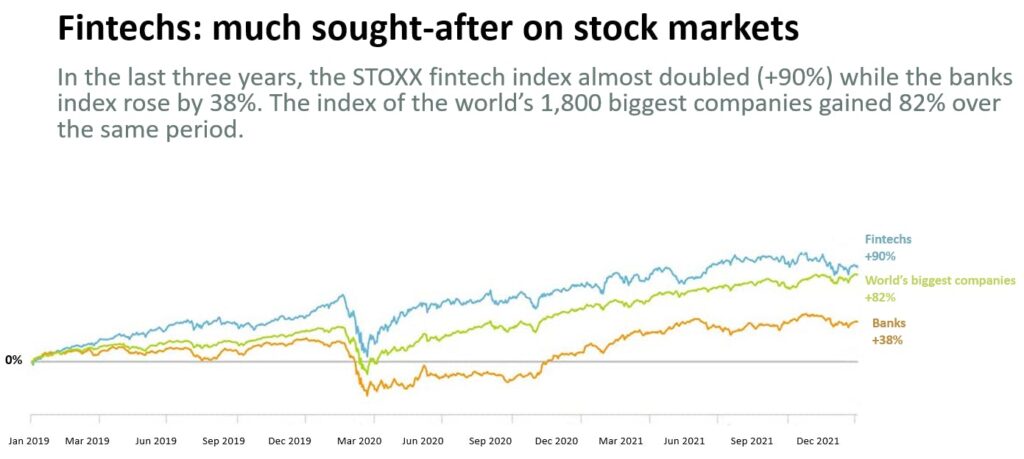A real driving force behind the current digital revolution, fintechs1 – a portmanteau of “finance” and “technology” that emerged a few years ago – did not have to wait for the COVID-19 crisis before experiencing very strong growth. This trend is likely to continue over the coming years given the digital shift of consumers.
Pushed to the forefront during the health crisis, fintech services – from online payments to loans – benefitted from the search for contactless solutions and transactions that could be carried out remotely. While these services existed before the pandemic, COVID-19 has accelerated the acquisition of new habits and completely changed consumer behaviour.
Consequently, the global fintech market should grow by an average of nearly 27% per annum between 2020 and 2026, according to one recent study: The Global FinTech Market Report 2021.
Such prospects have not failed to attract investors. According to the Boston Consulting Group, investment in fintechs surged by 173% between the third quarters of 2020 and 2021. Stocks in these companies have been very popular over the past three years.

Stoxx Global Fintech, Stoxx Global 3000 Banks and Stoxx Global 1800 indices
However, fintechs may still hold potential as some industry players are managing to gain considerable market share given their great flexibility and the cutting-edge technologies that they use.
Here are five reasons why we think you should keep a close eye on fintechs:
Credit market
Fintechs’ technological skills and natural aptitude for collecting and processing data to meet clients’ expectations enable them to offer better interest rates than traditional banks. These companies are also more transparent in their pricing, which helps them to gain the trust and secure the loyalty of their users.
They also offer increasingly in-demand services such as “buy now, pay later”2 . Fintechs earn their money by charging sellers a commission for purchases made through them, and clients a fee for any late repayments.
Payment
Since the pandemic, online and contactless payment solutions have continued to grow, to the extent that traditional plastic card payments could soon disappear. In the United States, it is thought that two out of every five store purchases will be settled by mobile phone within the next five years, i.e. four times more than at present.
Similar growth is expected in other developed countries, and this trend could even come about earlier in emerging markets, where many people are going straight from cash to mobile phone payments.
Away from consumer spending, some fintechs are also developing solutions to considerably smoother B-to-B transactions by making the internal processes behind payment delays more efficient. These digital services could attract companies that are currently waiting an average of nearly 70 days to be paid by their business clients.
Cryptocurrencies
Rapidly expanding for a little over a decade, cryptocurrencies3 may be the phenomenon that has done the most to shake up a finance industry hitherto accustomed to currencies being managed by central banks. Higher public spending, which has increased massively during the health crisis, has fuelled fears of seeing central banks finance governments.
These concerns have prompted a growing number of companies to put their cash into cryptocurrency, the best known of which is Bitcoin. Then there is the fact that some companies want to use these virtual currencies as means of payment.
Yet these solutions are not without risk. First of all, the authorities are paying increasingly close attention to these currencies at a time when amateur investors are speculating on them heavily. Moreover, it is practically impossible to estimate the value of these currencies, which are not tied to any economy. And unlike gold, these virtual assets are too recent to be considered an alternative store of value.
The growth seen in this field is nonetheless likely to continue with interest widened to 1) more and more professional investors, 2) the whole of the cryptographic ecosystem – encryption guaranteeing the inviolability of data – from cryptocurrencies to trading of alternative financial assets.
Cybersecurity
With the development of digital solutions, financial institutions are facing new security challenges. An increasing number of transactions, growing demand for less restrictive authentication processes, and the surge in online attacks have made cybersecurity solutions essential to the financial sector.
Demand for new generation security software has never been as strong. According to Gartner, a research and consulting firm, the global finance industry’s IT expenditure is likely to grow by an average of around 6.5% per annum between now and 2025.
Responsible investment
Environmental, Social and Governance (ESG) criteria are now central to investors’ interests. Fintechs actually resolve certain social problems.
The services that they provide give access to solutions that might otherwise have been too expensive, or impossible to apply in certain regions. In emerging countries, for example, where few people have a bank account, fintechs have already helped bring some local communities out of poverty. Nowadays, a bank account is no longer needed to take out a loan or insurance. A phone is all it takes.
2Offer allowing clients to pay for items in several instalments, for example over a period of six weeks. These loans are generally taken out at zero percent interest.
3Virtual means of payment used essentially on the Internet, based on cryptography – encryption guaranteeing the inviolability of data – to secure transactions and the creation of units, while avoiding any control from regulators and central banks.

